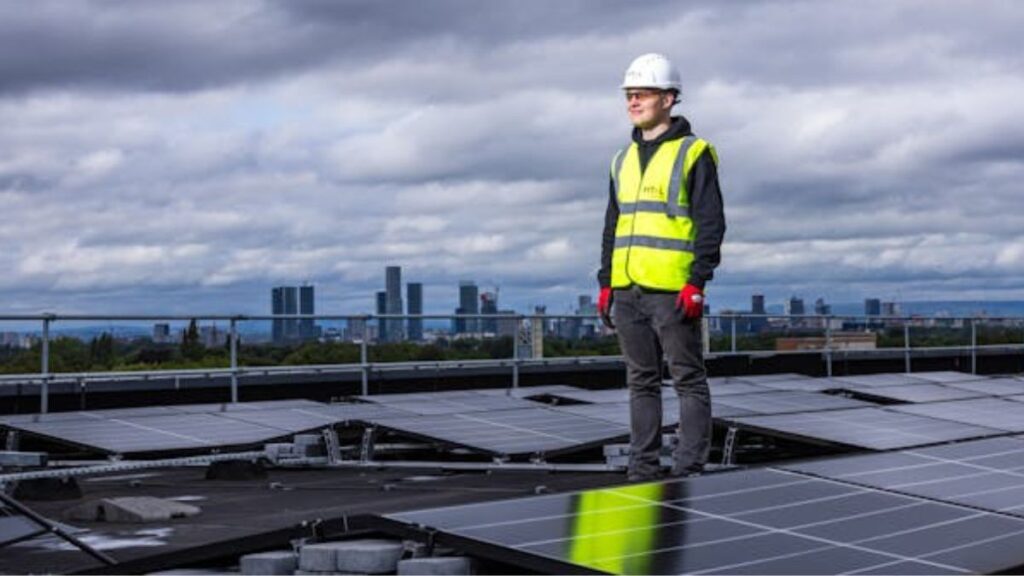Solar photovoltaic (PV) technology has transformed the way we generate electricity, providing a renewable and sustainable source of power. Solar PV systems convert sunlight into electricity, offering an eco-friendly alternative to fossil fuels. This technology not only contributes to reducing greenhouse gas emissions but also has the potential to reduce electricity costs significantly. Here, we’ll break down how solar PV works, its advantages, and some exciting advancements in the field that are expanding its applications.
1. How Solar PV Works
Solar PV technology operates on the principle of converting sunlight directly into electricity through the photovoltaic effect. A solar panel is made up of many small units called solar cells, usually crafted from silicon, a semiconductor material. When sunlight hits these cells, it energizes the electrons in the silicon atoms, setting them in motion and generating an electric current.
Each solar cell produces a small amount of power, but when grouped together in panels, they create enough electricity to power homes, businesses, and even large facilities. This generated electricity is typically direct current (DC), which must be converted to alternating current (AC) using an inverter. AC is the type of electricity used in most homes and businesses.
The amount of electricity produced by a solar PV system depends on factors like the intensity of sunlight, the angle of the panels, and even the temperature. Optimal panel placement and orientation are crucial for maximizing energy production, making professional installation an important step for achieving efficiency.
2. Types of Solar PV Systems
Solar PV systems come in different types, each tailored to specific needs:
- Off-Grid Systems: Designed to function independently of the utility grid, these systems are ideal for remote areas where grid access is limited. They include battery storage to supply power during cloudy days or at night.
- Grid-Tied Systems: These systems are connected to the local utility grid, allowing homeowners to offset their electricity bills and, in some cases, even sell excess power back to the grid. Grid-tied systems are popular for residential and commercial installations.
- Hybrid Systems: Combining the benefits of both off-grid and grid-tied setups, hybrid systems use batteries for storage but can also connect to the grid. They offer greater flexibility by providing power during outages and reducing reliance on the grid.
Each system type has its benefits and challenges. Off-grid systems, for example, provide energy independence but require significant upfront investment in battery storage. On the other hand, grid-tied systems can lead to lower electricity bills but are still partly dependent on the utility grid.
3. The Benefits of Solar PV Systems
The advantages of solar PV are numerous, ranging from environmental to financial:
- Renewable Energy Source: Solar energy is an abundant and renewable source of power. As long as the sun shines, we have a virtually endless supply of energy.
- Reduced Electricity Bills: Solar PV systems allow homeowners and businesses to generate their own electricity, which can substantially reduce energy costs. Pairing a solar PV system with an energy provider like perigee energy can further optimize savings by offering competitive rates and sustainable energy options.Many countries also offer incentives, such as tax credits and rebates, to make solar installations more affordable.
- Low Maintenance Costs: Solar systems require minimal maintenance, mainly consisting of keeping panels clean and ensuring there is no shading on the surface. Modern panels have a lifespan of 25-30 years, making them a durable investment.
- Environmental Impact: Solar PV generates clean energy, which reduces dependence on fossil fuels and helps lower carbon emissions. By choosing solar, individuals and businesses contribute to a cleaner and more sustainable environment.
- Energy Independence: Off-grid and hybrid systems provide a level of energy independence, helping users avoid power outages and fluctuations in electricity prices.
4. Solar PV and Agriculture
One of the exciting advancements in the field of solar PV is agrisolar, which involves using solar panels in agricultural settings to benefit both energy production and crop cultivation. It combines agriculture with solar technology by installing solar panels over fields or grazing lands, allowing farmers to produce crops while generating renewable energy.
This dual-use approach offers several benefits. First, solar panels provide partial shading, which can help protect certain crops from extreme heat, reduce evaporation, and conserve soil moisture. This is especially valuable in arid regions where water conservation is critical. The revenue generated from selling electricity can help offset agricultural costs, making farming more economically viable. Plus, agrivoltaics can benefit livestock farming by providing shade for animals, which helps reduce heat stress and improves animal welfare. This development highlights the versatility of solar PV technology, showing how it can be adapted to serve both energy and food production needs.
5. Cost and Financial Considerations
While the upfront cost of installing a solar PV system can be high, the long-term savings often justify the investment. Solar panels have become significantly cheaper over the past decade, and various incentives, such as tax credits, feed-in tariffs, and rebates, can help reduce the initial costs.
Grid-tied systems offer a way to earn money through net metering, a system where the excess electricity generated by your solar panels is sent back to the grid. Utility companies compensate users for this surplus energy, effectively reducing the overall electricity bill.
When evaluating the cost, it’s essential to consider the long-term benefits. The savings on electricity bills over 20-30 years can lead to a substantial return on investment. A well-installed solar PV system can increase property value, making it an attractive feature for potential home buyers.
6. Environmental Impact and the Path to Sustainability
Solar PV systems contribute to reducing greenhouse gas emissions and reliance on fossil fuels, making them a cornerstone of sustainable energy strategies. Unlike coal or natural gas, solar power does not release harmful pollutants into the atmosphere, reducing the impact on air quality and public health.
By generating clean energy, PV systems help mitigate the effects of climate change. The energy produced from solar PV offsets emissions that would have been generated by non-renewable sources, contributing to global carbon reduction goals. Adopting solar PV on a large scale is essential for creating a sustainable energy infrastructure for future generations.
7. Future Prospects and Emerging Technologies in Solar PV
The field of solar PV is continuously evolving, with new technologies emerging to improve efficiency and reduce costs. Advances such as bifacial solar panels, which capture sunlight from both sides of the panel, and solar tracking systems, which adjust the angle of the panels to follow the sun’s movement, are increasing the energy output of solar systems.
Research in solar cell materials, such as perovskite, promises even higher efficiency rates, potentially lowering the cost of solar power further. The integration of solar with battery storage technology is making it easier for individuals and businesses to rely on solar energy exclusively, without needing backup from the grid.
In the future, solar PV technology will likely become even more accessible and adaptable, expanding beyond traditional rooftops and ground-mounted systems. Floating solar farms, and building-integrated photovoltaics (BIPV)all indicate a bright future for solar energy.
Solar systems are transforming the energy landscape by offering a sustainable, renewable alternative to traditional power sources. Understanding how solar PV works and recognizing its many benefits allows individuals and businesses to make informed decisions about adopting this technology. With innovations expanding its applications, solar PV has the potential to play a critical role in addressing both energy and environmental challenges. By investing in solar PV, we can move closer to a future powered by clean, renewable energy.







